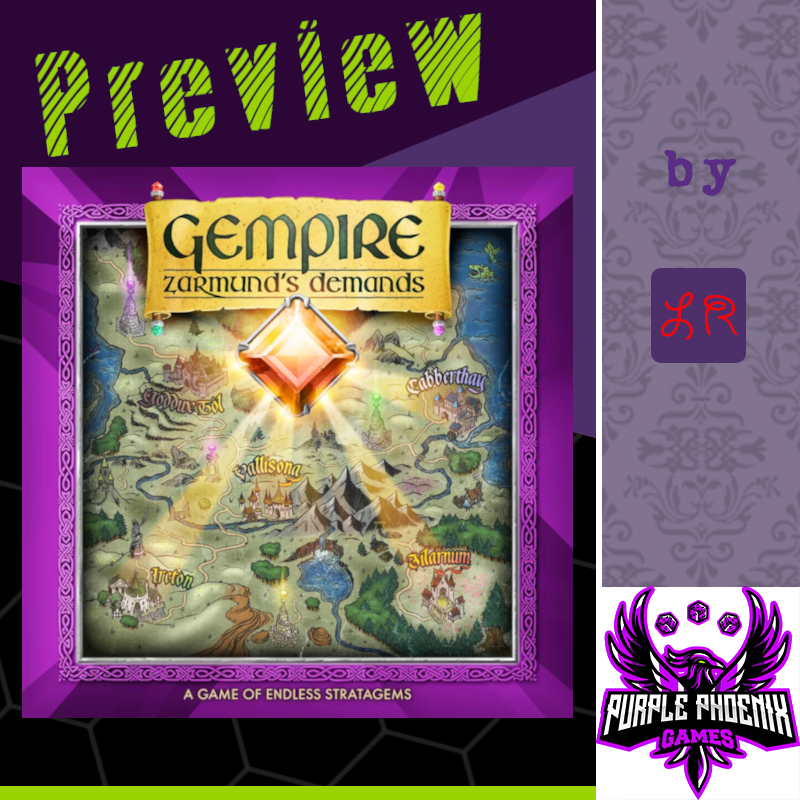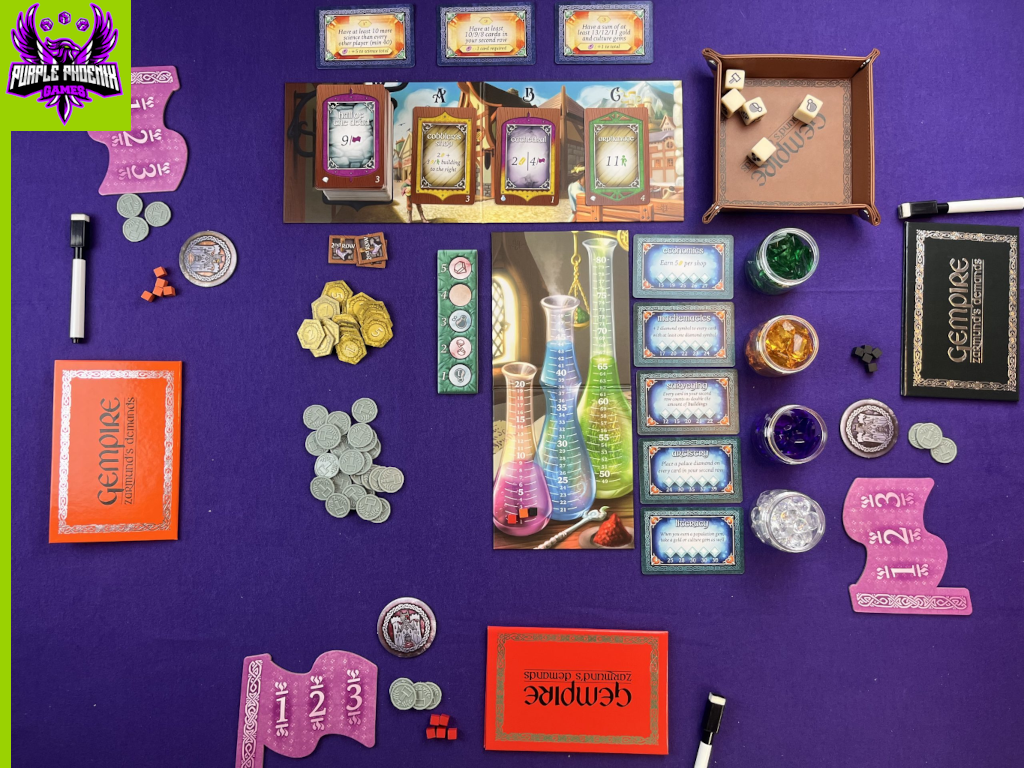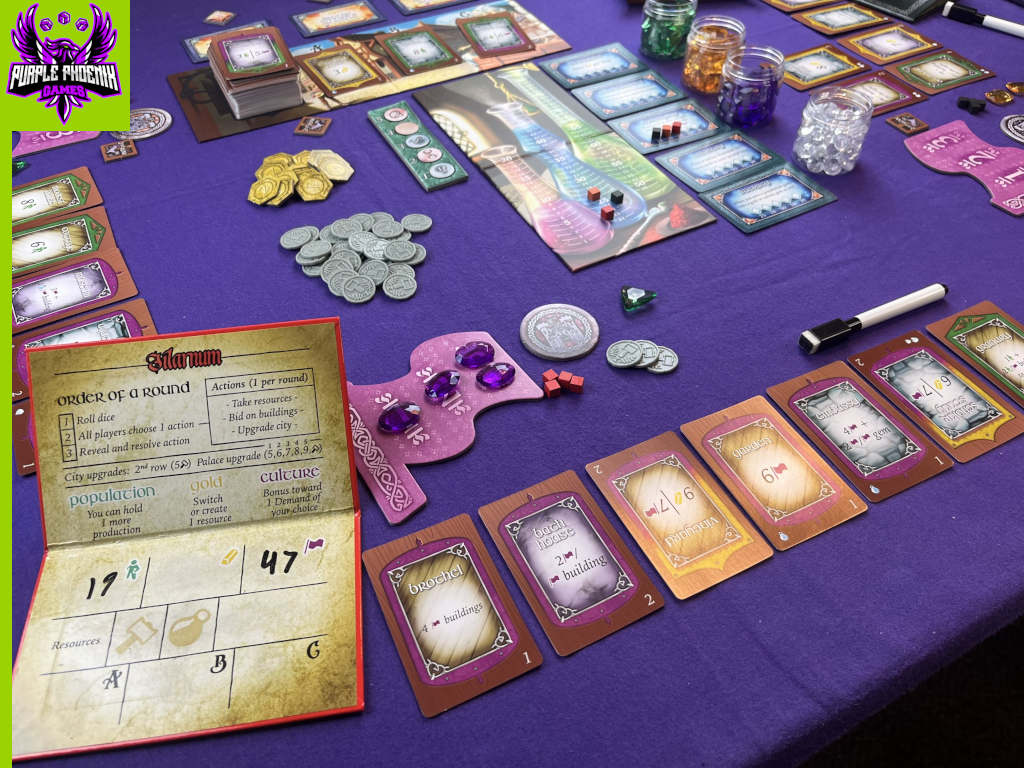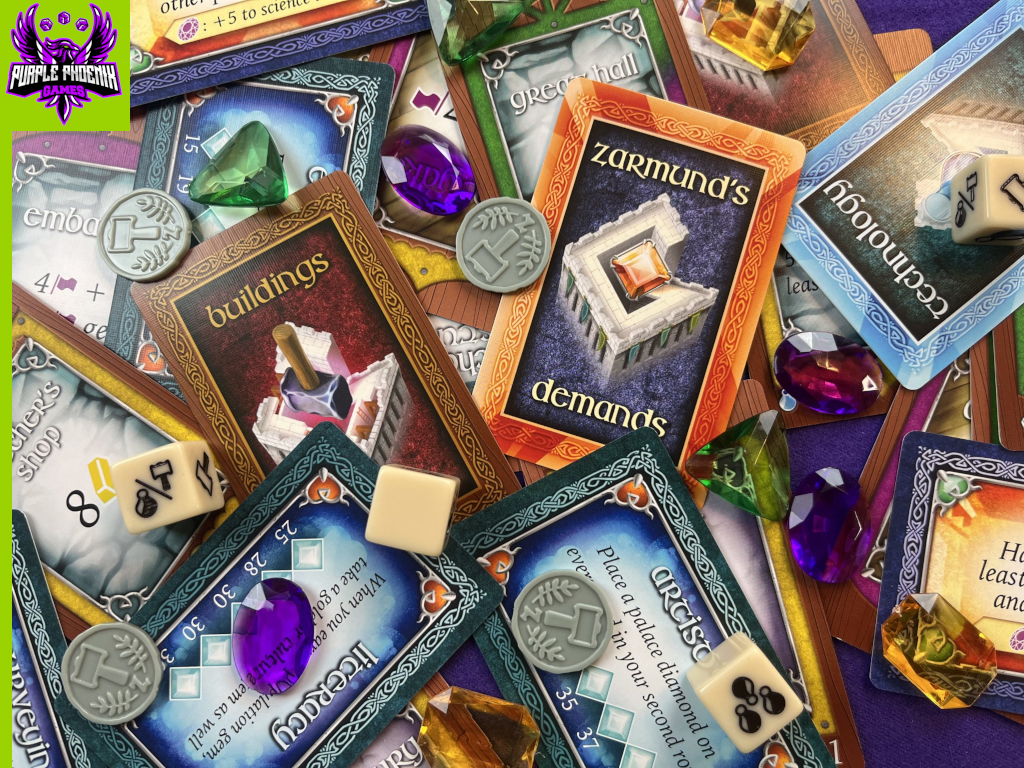
King Zarmund, the powerful ruler of the empire in which you live, is not happy. And when the King isn’t happy, nobody is! So what’s got him down? He thinks his capital city is lame. He wants a city that is extravagant, mighty, and impressive to be his seat of power. So he’s on the hunt for a new capital to rule from, and that’s where you come in. As the leading architect in your city, you have the perfect opportunity to put your skills to work and build the greatest city that King Zarmund has ever seen! He’ll have no choice but to relocate to your amazing city, and he’ll probably also reward you handsomely for your impressive work! Be quick and strategic about it, though, as several other cities have the same idea as you do – there can only be one capital city, after all…
| Gempire: Zarmund’s Demands (2023) | Gem Time Games |
| 3-5 players | 45-90 minutes |
| Ages 14+ | BGG Weight – 3.00 / 5 |
Disclaimer: We were provided with a copy of Gempire for the purposes of this preview. I also do not intend to rehash the entire rulebook in this preview, but rather provide a general overview of the rules and gameplay. -L
Gempire: Zarmund’s Demands (simply referred to as Gempire for the remainder of this preview) is a strategic city building game in which players are competing to create the best capital city. Played over a series of rounds, players will simultaneously be taking turns to perform actions in order to build buildings, upgrade their cities, discover technologies, and meet the specific demands of King Zarmund. To setup for a game, place the Building and Science Boards in the center of the table. Shuffle the deck of Building Cards and create a market on the Building Board. Shuffle and randomly select 5 Technology Cards and place them face-up next to the Science Board. Randomly select 3 Zarmund’s Demand cards and place them face-up above the Building Board. Randomly select 5 Palace Reward Tokens and place them to the side of the Science Board. Each player receives a Planning Book, marker, palace token, Culture Flag, and wooden cubes in their chosen color. Place the Production Coins and Gems to the side. Select a starting player, and the game is ready to begin! Setup for a 3-player game is pictured below.

Each round is broken down into 3 steps: Roll Dice, Action Selection, and Reveal/Resolve. To start is the Roll Dice step – the active player rolls all of the Resource Dice. The Resource Dice can give you either Production Coins (used to buy Buildings), Science (used to discover Technologies), or will have blank faces that earn no resources. Once the dice have been rolled, we move to the Action Selection step. All players will simultaneously and secretly select an Action to perform this round. The options are: Collect Resources, Bid on Buildings, or Upgrade City. Whichever action you choose to take, you will write it in your Planning Book. To Collect Resources, write down the number of each resource you will collect this round (ex. 3 Production, 2 Science). To Bid on Buildings, write your bid in your Planning Book in the space corresponding to the Building you want on the Building Board. And finally, to Upgrade City, write down to which level you wish you upgrade your City.
Once all players have secretly selected their Action, it is time to Reveal/Resolve. All players simultaneously reveal the Action they selected in their Planning Book, and then resolve them accordingly. Players who chose to Collect Resources will gain Production Coins and/or will advance their marker on the Science Board according to the values rolled on the Resource Dice this round. It is important to note that all players who choose to Collect Resources can collect every Resource rolled – it’s not like one player gets them ‘first’ and leave none for anyone else. The Resource Dice are available to all players every round. Players who Bid on Buildings resolve their bids now – if any players bid on the same building, the highest bid wins. Bids are paid in Production Coins, and are paid back to the general supply. If a player gets outbid for a Building, they must pay 1 Production Coin for losing! Whenever you win a Building, you immediately play it into your City Tableau, following the placement restrictions described in the rulebook. Any players who chose to Upgrade their City do so by paying Production Coins. A City Upgrade allows you to create a 2nd Row in your City Tableau, while a Palace Upgrade allows you to collect the Palace Rewards corresponding to the level of your upgrade.
Buildings in your City will earn you either Population, Gold, or Culture. These are tracked in your Planning Book, and for every 10 of each that you have, you will earn a Gem of that type. The Gems give you special abilities to use for the rest of the game. At any point during the Reveal/Resolve step, players may choose to discover a Technology if they have the requisite amount of Science earned. Technologies can grant you special and powerful abilities for use throughout the remainder of the game. Strategize wisely on your Buildings and Technologies, as you could create a chain to help catapult you towards victory!
When all players have resolved their actions, check Zarmund’s Demands. If no player meets 2 of the 3 Demand cards, the game continues. Players erase their Action choice from the previous round, the Resource Dice are passed to the next player, and the new round starts and is played as described above. If at the end of a round, a player does meet 2 of the 3 Demand cards at the end of a round, they are declared the winner!

So there’s kind of a lot going on in this game, but that’s part of what makes it so interesting. The game box even says, “A game of endless stratagems,” and that’s truly what it is. There are so many different strategies for players to take, and you must be constantly adapting your strategy throughout the game. There is no one right way to play and win, and that’s what keeps the gameplay refreshing and engaging. Do you focus on Buildings and beefing up your Population. Gold, and Culture Gems? Or should you aim to discover Technologies quickly for those sweet sweet abilities? You can’t do anything without collecting Resources, though, so do you want to build up a cache or spend ’em as soon as you’ve got ’em? It’s ultimately up to you, so put your brain to work!
In all of my plays, I’ve found myself trying a different strategy nearly every time. One thing that helps play into that is the secret and simultaneous action selection each round. You don’t know what your opponents are going to do, so you can’t react to their turns. You have to be solid in your approach, and adjust accordingly depending on how your opponents choose to play each round. There is a decent amount of player interaction here, but it’s not directly confrontational, as actions are selected in secret. Yeah, maybe you got outbid for a building, but you can’t take it personally, as they had no idea you were bidding as well! Another neat aspect of Gempire that I like is how Zarmund’s Demands work. They are open and available to all players throughout the entire game, and they are not ‘claimed’ by any one player when they have achieved that Demand. So just because you satisfy a demand in one round, doesn’t mean that you’ve got that one for the rest of the game! Depending on how the next round plays out, you may no longer meet those requirements when the new round is said and done! You’ve got to be constantly working and paying attention to your opponents so you can ensure you’ve got the Demands done. You have to simultaneously meet 2 of the Demands at the end of a round in order to win the game.
Components. The copy of Gempire that I was provided looks to be a finalized production copy – and it’s a pretty good one at that! The cardboard tokens are nice and thick, and the cards are sturdy and clear to read/understand. I really like the Planning Books and how you write in them with dry-erase markers – it’s a great way to deal with writing in a game without having to use a new sheet of paper every time you play. The Production Coins and the Gems are nice and chunky, and just plain fun to have in hand. The rulebook is in-depth and it explains the game well without much ambiguity. And for a game that is as involved as this one is, clarity in the rulebook is a huge boon. Great production quality overall!
My one qualm with the gameplay, though, has to do with discovering Technologies. You track your Science on the Science Board throughout the game, and Science is used to discover Technologies. However, the rulebook clearly states that when you discover a Technology, you do not move your Science tracker down on the Science Board. So as you play and discover more Technologies, you’ve got to be doing math to make sure you actually have enough Science to do so. For example, lets say you discover a Tech worth 15 Science. You do so, and do not move your Science marker down. Later, you want to discover a Tech worth 30 Science, so you actually need a total Science of at least 45 to do so (15 you already spent, plus the 30 for this new one). It just adds extra math into the game that could be solved if you just move your Science tracker back to zero whenever you discover a Technology. Yeah, some Demands talk about total Science, but in that case you can look at the Technologies you’ve discovered and add up the totals from there. There’s math either way, but the way as written in the rules just feels a little more confusing to me.
All in all, though, I am a fan of Gempire. There is a lot going on, and a lot to keep track of, but the strategic possibilities are vast and varied. I don’t think you’d ever play the same game twice, no matter how many times you bring Gempire to the table. I’ve enjoyed my plays of it, and the gameplay is becoming more natural to me as I get more comfortable with the rules – i.e. I don’t have to keep referencing the rulebook every round anymore. One person I played with has already asked me a couple of times about playing Gempire again, so to me that’s the sign of a good game! As this is a preview, Gempire isn’t out yet – but it will hit Kickstarter soon! Definitely be on the lookout for this one, as it keeps you constantly engaged, puts your strategies to the test, and is just plain fun to play!

